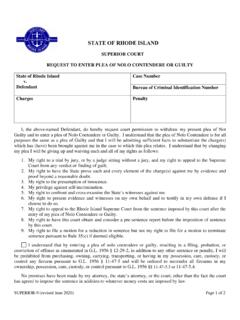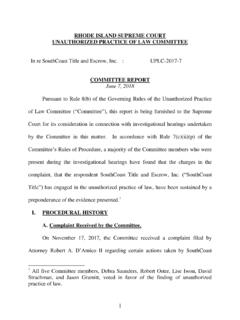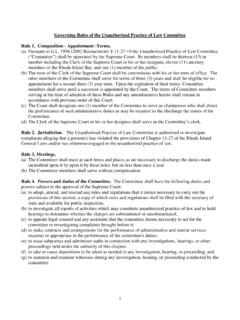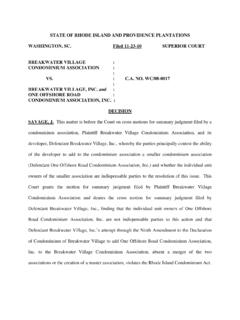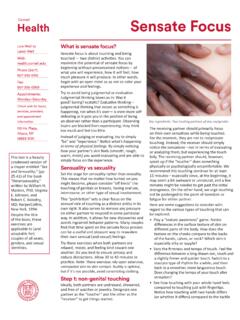Transcription of ACUTE HAND INJURY PROTOCOLS - Rhode Island
1 ACUTE HAND INJURY PROTOCOLS I. FRACTURES OF THE HAND AND DIGITS A. Background Digital and hand fractures are seen in many settings and more commonly in situations involving machinery and heavy labor. Most fractures are due to local trauma caused by an applied force. The energy of applied force determined the severity of the fracture. Digital fractures are much more common than hand fractures, and may present as open fractures with soft tissue loss. B. Medical History 1. Pain, swelling, and discomfort to the injured digit, thumb, or hand 2. Age, occupation, activities, hand dominance, history of previous hand INJURY /impairment important to document 3.
2 Date of INJURY , as well as time interval between INJURY and treatment 4. Conditions surrounding INJURY (physical environment) Assists in determination of dirty vs. clean wound 5. Mechanism of INJURY C. Physical Examination 1. Swelling and tenderness of the affected part 2. Digital range of motion 3. Vascular changes (ischemic, congestion, or cyanosis) 4. Neurologic changes (including two-point discrimination) 5. In digital fractures, notation of the soft tissue envelope and the presence of any skin interruption, consistent with an open fracture, should be sought.
3 D. Appropriate Diagnostic Tests and Examinations 1. X-rays, including true lateral views of the involved digit/metacarpal bone. Occasionally advanced imaging (MRI, CTScan) for evaluation of fracture pattern 2. Occasionally, noninvasive/invasive vascular studies may be useful and appropriate, when there is suspicion of circulatory compromise. Such studies include: a. Doppler b. Ultrasound c. Angiogram d. MRA E. Outpatient Treatment: Uncomplicated Fractures 1. Uncomplicated digital fractures are expected to obtain boney union within four to six weeks. OT/PT often can begin at 3 weeks to attempt to avoid stiffness.
4 2. Indications for Treatment a. Pain b. Limited Motion c. Swelling 3. Treatment Options: Closed Reduction With/Without Anesthesia a. Digital finger splints b. Intrinsic plus splints c. Buddy taping d. Intrinsic plus casting e. Casting 4. Rehabilitation a. After initial healing (confirmed by exam/x-ray), active and passive range of motion exercises of the digits, hand and wrist b. Grip strengthening exercises, when indicated c. Activity modification may be necessary. 5. Duration of Care a. Generally extends over 6-12 weeks b.
5 Duration depends on severity of wound, complications, and complexity of care required for healing and optimization of functional restoration. F. Closed Reduction, Internal Fixation/Open Reduction, Internal Fixation/Surgically Treated Injuries 1. Indications a. Failure to respond to conservative measures b. Failure to correct digital deformity/displacement (seen in AP, lateral, or rotatory x-ray views) or by clinical exam c. Intra-articular joint fracture that cannot be adequately treated by closed measures d. Open fractures requiring irrigation and debridement e.
6 Amputations 2. Treatment Options a. Closed reduction with/without internal fixation b. Open reduction with/without internal fixation c. Irrigation and debridement d. Closed reduction or external fixation 3. Rehabilitation a. Following initial healing, active and passive range of motion exercises of the digits, hand and wrist b. When indicated, grip strengthening exercises c. Activities of daily living modification d. Activity limitations e. Range of motion exercises (after fracture healing) f. Splinting/casting 4. Duration of Care a. Operative treatment: 3-6 months following surgery II.
7 DIGIT AND HAND DISLOCATIONS A. Background Dislocations require tearing of some of the structures surrounding the joints of the digits, hand, and/or wrist. All injuries of this sort must be reduced to allow for adequate post- INJURY function. Unduly lengthy immobilization following these injuries can lead to stiffness in the affected part. Often accompanying these injuries is cartilaginous disruption, resulting in eventual joint (traumatic) arthritis. B. Diagnostic Criteria 1. Precipitating INJURY History/Mechanism of INJURY a. Usually involves a hyperextension type INJURY (digits) b.
8 Metacarpal dislocations often involve a direct blow to the knuckles c. Usually presents with severe pain, swelling, and deformity of the hand or digit 2. Physical findings a. Swelling b. Pain c. Limited motion C. Appropriate Diagnostic Tests and Examinations 1. Digital X-rays: true lateral views of the digits, including AP, lateral, and oblique pre and post-reduction views. Occasionally advanced imaging 2. Hand X-rays: true lateral radiographs, including metacarpals, with AP, lateral, and oblique pre and post-reduction views. Occasionally advanced imaging D.
9 Outpatient Treatment 1. Nonoperative Treatment a. Varies according to INJURY severity b. Can include closed reduction of digital joints under local anesthesia c. Immobilization after reduction, including digital splints, intrinsic-plus splints of the hand or wrist, and casting 2. Rehabilitation a. Can include active/passive range of motion exercises, beginning 2-6 weeks after INJURY b. Grip strength exercises, when indicated c. Activities of daily living modification d. Activity modification 3. Surgery a. Indications Inability to reduce a dislocation under closed conservative treatment Open digital dislocation Irreducible joint dislocations with extensor and/or flexor tendon involvement Fractures associated with dislocations b.
10 Surgical Options Closed reduction under anesthesia Closed reduction, internal fixation Open reduction Open reduction, internal fixation, with ligament or tendon repair c. Post-operative rehabilitation Although this group may require extended periods of rehabilitation, generally required rehabilitation components approximates that of the nonoperative group 4. Estimated Duration of Care a. Varies depending on severity of tissue damage, complication occurrence III. WRIST FRACTURES AND DISLOCATIONS A. Background Fractures and dislocations of the wrist are frequently missed emergent musculoskeletal injuries.
